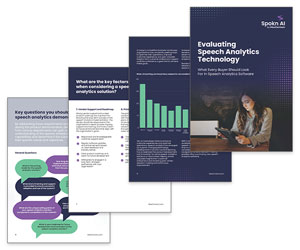Jas Bansal of Foehn promotes the use of speech analytics to improve your contact centre’s performance on the phone channel.
There are two strong themes at the core of our contact centre development philosophy at Foehn.
The first is the removal of complexity, giving the user an intuitive and easy experience.
The second is ‘getting voice right’.
Voice conversation with a human agent is consistently the preferred channel for the majority of consumers.
For the minority that prefer first contact via digital channels, it is also a critical requirement for specific, more sensitive conversations and back-up for interactions where digital fails.
Over the years, a hugely valuable derivative of a voice-first approach has now permeated from the contact centre into core business management. That is speech analytics.
The technology has moved rapidly from simply validating compliance within call recordings, passing through the usual hype and emerging today as a mature service that delivers customer insight to operational management throughout the business.
In turn, the role of voice in the contact centre has risen to a whole new level.
Executives outside the contact centre are now taking a multi-departmental approach to understanding and using speech analytics.
Typically, these insights support marketing strategies, advertising tactics, improved customer experience and plans for digitalization.
Less typically, they also act as drivers of workforce optimization, fraud detection and identification of customer intent, particularly customer experience failures.
A study by Opus Research indicates that agent training, regulatory compliance and unhappy customers are at the top of the speech analytics list of targets.
Product development can benefit from insights, good and bad, whilst the analytics can also detect up-sell and cross-sell opportunities.
Not surprisingly, the predictive capabilities of speech analytics have attracted the attention of internal sales teams and field sales operations.
By matching the sales pitch with predictive insight of a prospect’s requirements, sales teams can remain compliant in their approach whilst raising the conversion rate within the sales pipeline.
Either way, some 89% of decision-makers plan to use speech analytics for business purposes outside contact centre operations, but not without some resistance. Cost and return on investment have been issues causing some hesitancy in adoption over recent years.
Software customization and professional services have incurred costs that have slowed wide-scale deployment beyond the contact centre.
However, true to form, these costs are falling as solutions become more ‘out of the box’ and integration becomes easier to fulfil. Return on investment is now a reality and systems are becoming affordable, even for small businesses.
Peeling back the hype reveals a consensus of business management opinion that sees the current strength of speech analytics resting on three pillars: rapid recognition or anticipation of a crisis, improved customer intention/engagement and better sales conversion rate.
Beyond this, the scope for speech analytics seems limitless. Even now, it seems that the business case has hardly scratched the surface.
Author: Foehn
Published On: 10th Sep 2019 - Last modified: 26th Feb 2025
Read more about - Expert Insights, Analytics, Call Handling, Foehn
















